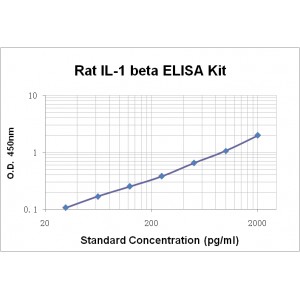More info
Assay Range | 31.2-2,000 pg/mL |
Sensitivity | 2.0 pg/mL |
Specificity | No cross-reaction with other related substances detected |
Size | 96T |
Storage | Store at 2 - 8ºC. Keep reconstituted standard and detection Ab at -20 ºC |
Assay Principle | Sandwich ELISA |
Sample Volume | 100 µL final volume, dilution factor varies on samples |
Detection Method | Chromogenic |
Kit Components
1. Recombinant Rat IL-1beta standard: 2 vials
2. One 96-well plate coated with Rat IL-1beta Ab
3. Sample diluent buffer: 12 mL - 1
4. Detection antibody: 130 µL, dilution 1:100
5. Streptavidin-HRP: 130 µL, dilution 1:100
6. Antibody diluent buffer: 12 mL x1
7. Streptavidin-HRP diluent buffer: 12 mL x1
8. TMB developing agent: 10 mL x1
9. Stop solution: 10 mL x1
10. Washing solution (20x): 25 mL x1
Background
The Interleukin 1 (IL-1) family consists of the classic members IL-1α, IL-1β, IL-1ra, IL-18, IL-33 and IL-1F5-F10. In response to inflammatory agents, infections, or microbial endotoxins, IL-1 is significantly produced by macrophages and various other cell types. IL-1α is mainly expressed and secreted by activated macrophages, neutrophils, epithelial cells, and endothelial cells. It plays a key role in regulating the immune responses. IL-1α is approximately 25% identical to IL-1β. Both IL-1α and IL-1β are synthesized as 31 kDa precursors that can be further cleaved into mature proteins of approximately 17.5 kDa. Cleavage of the IL-1β precursor by Caspase-1/ICE is a key step in the inflammatory response. The precursor form of IL-1β, unlike the IL-1αprecursor, exhibits little or no biological activity in comparison to its mature form.
IL-1α and IL-1β bind to transmembrane type I receptor (IL-1 RI) associated with IL-1 RAcP and type II receptor (IL-1 RII) to activate the downstream signaling pathways. IL-1ra is a secreted protein and functions as a competitive inhibitor of IL-1. IL-1 RII itself does not appear to signal in response to IL-1 and may function as a decoy receptor that attenuates IL-1 function. IL-1β plays a central role in immune and inflammatory responses, bone remodeling, fever, carbohydrate metabolism, and GH/IGF-I physiology. Inappropriate or prolonged production of IL-1 has been implicated in a variety of pathological conditions including sepsis, rheumatoid arthritis, inflammatory bowel disease, acute and chronic myelogenous leukemia, insulin dependent diabetes mellitus, atherosclerosis, etc.


